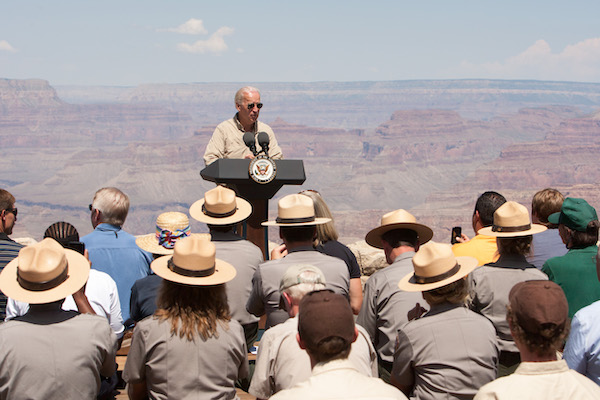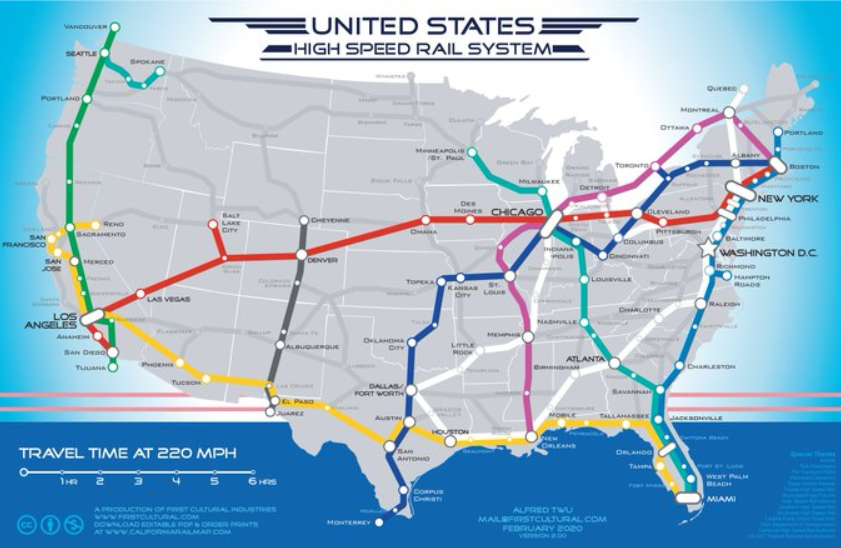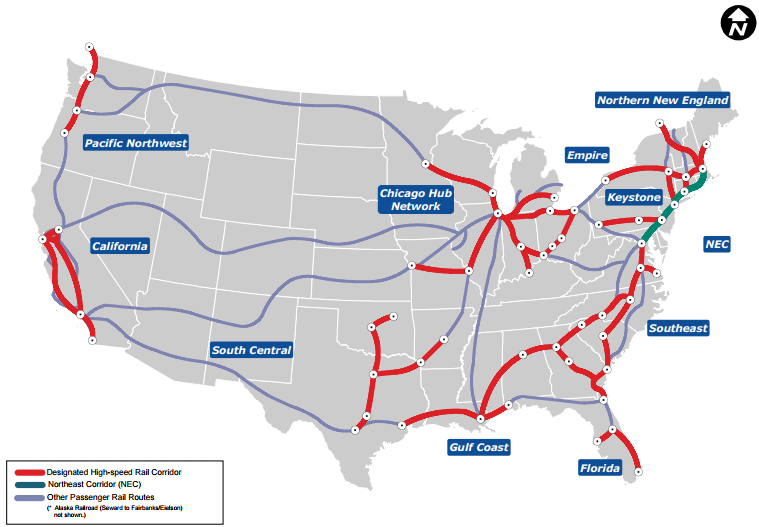
While Joe Biden may have emphasized highway building during the virtual Democratic National Convention, his $2 trillion dollar “Build Back Better” climate plan is built on transit. When Biden rolled out the plan in July, he did a great job of stressing the urgency and tightly linking climate action to job creation and economic recovery.
“I know meeting the challenge would be a once-in-a-lifetime opportunity to jolt new life into our economy, strengthen our global leadership, protect our planet for future generations,” Biden said. “If I have the honor of being elected president, we’re not just going to tinker around the edges. We’re going to make historic investments that will seize the opportunity, meet this moment in history.”
Biden’s campaign told NPR the climate plan would seek to shift major cities toward public transportation and “create millions of good, union jobs rebuilding America’s crumbling infrastructure.”
Biden’s earlier climate plan had promised to invest $1.7 trillion over a decade, but after consulting with climate leaders (including former presidential opponents like Governor Jay Inslee, Senator Bernie Sanders, and Senator Elizabeth Warren), he increased that to $2 trillion on a faster timetable with more aggressive targets for converting to 100% clean energy–2035 for the power sector and a 2050 target for zero emissions overall. The new plan promises to:
- Upgrade four million buildings to increase energy efficiency;
- Weatherize two million homes:
- Install 500,000 electric vehicle charging stations by 2030; and
- Establish office of environmental and climate justice at the Department of Justice.
The primary season plan had gotten an “F” from the Sunrise Movement, but Biden’s updated plan has drawn praise from climate leaders. Moreover, Biden’s choice of Senator Kamala Harris as his running mate was also greeted as a climate positive by the Sunrise Movement and others since she had came around to backing the Green New Deal during her own presidential bid.
The rail plan
Even before he augmented his climate plan in July, he set ambitious goals for high-speed rail, promising to “spark the second great railroad revolution.”
“Two centuries ago, the first great railroad expansion drove our industrial revolution. Today, the U.S. is lagging behind Europe and China in rail safety and speed. Biden will develop a plan to ensure that America has the cleanest, safest, and fastest rail system in the world–for both passengers and freight,” the climate plan stated.
Moreover, it’s clear Biden is thinking in terms of a connected national network and economic stimulus rather than a few one-off projects upgrading the existing Amtrak network, as President Obama’s stimulus package ended up being watered down to give the lesser investment and obstruction from Republican governors like Wisconsin’s Scott Walker and Florida’s Rick Scott.
“He’ll start by putting the Northeast Corridor on higher speeds and shrinking the travel time from D.C. to New York by half–and build in conjunction with it a new, safer Hudson River Tunnel,” the plan said. “He will make progress toward the completion of the California High Speed Rail project. He will expand the Northeast Corridor to the fast-growing South. Across the Midwest and the Great West, he will begin the construction of an end-to-end high speed rail system that will connect the coasts, unlocking new, affordable access for every American.”

Beyond that, Amtrak Joe — as Biden is nicknamed — also signaled interest in upgrade freight networks and specifically called out I-5’s Columbia crossing between Oregon and Washington.
“With respect to freight: A Biden Administration will pursue projects like a bridge that connects Oregon and Washington State that moves not only trucks but rail transit, and the completion of the CREATE project in Chicago that could cut in half the time it takes vital goods to move through the country. This plan will reduce pollution, help connect workers to quality jobs with shorter commutes, and spur investment in communities more efficiently connected to major metropolitan areas.”
While it’s nice to get the regional shoutout, the new Columbia bridge also has the makings of a highway widening boondoggle. Running track on the bridge for high-speed rail would lessen the sting, certainly. While the Washington State Department of Transportation (WSDOT) has estimated adding one lane in each direction of I-5 statewide would cost $110 billion, high-speed rail would cost less, emit zero emissions, cut travel times to about an hour from Seattle to Portland or Vancouver, British Columbia, and be immune to traffic jams. If improving freight connectivity is the goal, toll lanes and freight rail improvements could speed the transport of goods better than freeway widenings every could.

Openings for local transit/bike/ped infrastructure
Biden pledged he would “empower” local jurisdictions to develop their transportation priorities for federal funds. While a more hardline environmentalist candidate may have offered strong national requirements for pedestrian, bicycle, and transit infrastructure, Biden’s approach definitely marks a step forward, particularly in cities where enlightened leaders are in power.
“Communities across the country are experiencing a growing need for alternative and cleaner transportation options, including transit, dedicated bicycle and pedestrian thoroughfares, and first- and last-mile connections,” the climate plan states. “The Biden Administration will transform the way we fund local transportation, giving state and local governments, with input from community stakeholders, more flexibility to use any new transportation funds to build safer, cleaner, and more accessible transportation ecosystem.”
The downside of empowering local transportation authorities is that many states and cities remain hopelessly carcentric. It could lead to an uneven growth in walkability, bikeability, and transit quality, exacerbating current inequalities. But more flexible federal funding is a great first step and quite the contrast.
Under Trump, the federal transportation administration has often gummed up the works and delayed funding for transit projects despite existing funding agreements and has been slower in doling out new money. Biden’s administration would clearly be far more cooperative and competent.
Electric car subsidies
Another emphasis of Biden’s plan is a national system of electric vehicle (EV) charging stations. While perhaps carcentric from an urbanist perspective, greatly expanding charging stations seems like an eventuality if we hope for a nationwide ban on carbon pollution-emitting vehicles any time soon.
“As President, Biden will work with our nation’s governors and mayors to support the deployment of more than 500,000 new public charging outlets by the end of 2030,” the plan says. “In addition, Biden will restore the full electric vehicle tax credit to incentivize the purchase of these vehicles.”
Restoring Obama-era EV tax credits seems like a dubious strategy since electric car adoption rates remain so low–still below 1% of the staggering 274 million registered vehicles in the United States–even after several years of tax credit incentives. It would be better to lower living costs for low-income and middle-class families in other ways than subsidizing car ownership. But, if we’re going to go that route, environmentalists should fight to include electric bikes and scooters in the subsidy since they are much climate-friendlier due to less embodied carbon and less land use impacts.
Dense ideas
Not specifically mentioned in the climate plan is single-family zoning reform, but Biden’s housing plan did include significant incentives for jurisdictions that loosen zoning restrictions to promote affordable housing. Transitioning away from exclusionary zoning is crucial because better land use and less sprawl will be key to any viable climate strategy. Denser living patterns allow a transit system to run efficiently while sparing wilderness, forest lands, and agricultural lands from the endless thirst for suburban tract housing. If we hope to sequester carbon in forests, we can’t keep paving over millions of acres for suburban sprawl.
Of course, Republicans, in their truly reactionary form, have seized on this modest policy idea as signaling Biden’s intent to “abolish the suburbs” as Trump put in several racist dogwhistle/bullhorn tweets and comments. By making such a starkly classist and racist appeal, Trump may have finally made some liberals reexamine their own housing opposition and support for apartment bans–time will tell.
Despite desperate opposition from Republicans, Democrats should embrace urban density and the Green New Deal as the bedrock of their next administration. The time to negotiate with unhinged climate deniers is over–our goal should be to win big this election and consolidate power so that the party of climate denial and racist dogwhistles becomes irrelevant.
Doug Trumm is publisher of The Urbanist. An Urbanist writer since 2015, he dreams of pedestrian streets, bus lanes, and a mass-timber building spree to end our housing crisis. He graduated from the Evans School of Public Policy and Governance at the University of Washington in 2019. He lives in Seattle's Fremont neighborhood and loves to explore the city by foot and by bike.

